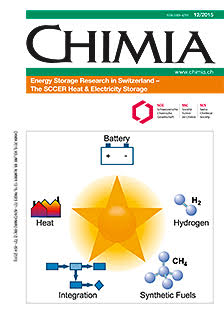Phase Change Material Systems for High Temperature Heat Storage
DOI:
https://doi.org/10.2533/chimia.2015.780Keywords:
High-temperature heat storage, Latent heat of fusion, Multimode heat transfer, Phase change materials, Thermal energy storageAbstract
Efficient, cost effective, and stable high-temperature heat storage material systems are important in applications such as high-temperature industrial processes (metal processing, cement and glass manufacturing, etc.), or electricity storage using advanced adiabatic compressed air energy storage. Incorporating phase change media into heat storage systems provides an advantage of storing and releasing heat at nearly constant temperature, allowing steady and optimized operation of the downstream processes. The choice of, and compatibility of materials and encapsulation for the phase change section is crucial, as these must guarantee good and stable performance and long lifetime at low cost. Detailed knowledge of the material properties and stability, and the coupled heat transfer, phase change, and fluid flow are required to allow for performance and lifetime predictions. We present coupled experimental-numerical techniques allowing prediction of the long-term performance of a phase change material-based high-temperature heat storage system. The experimental investigations focus on determination of material properties (melting temperature, heat of fusion, etc.) and phase change material and encapsulation interaction (stability, interface reactions, etc.). The computational investigations focus on an understanding of the multi-mode heat transfer, fluid flow, and phase change processes in order to design the material system for enhanced performance. The importance of both the experimental and numerical approaches is highlighted and we give an example of how both approaches can be complementarily used for the investigation of long-term performance.Downloads
Published
2015-12-16
Issue
Section
Scientific Articles
License
Copyright (c) 2015 Swiss Chemical Society

This work is licensed under a Creative Commons Attribution-NonCommercial 4.0 International License.
How to Cite
[1]
Chimia 2015, 69, 780, DOI: 10.2533/chimia.2015.780.







